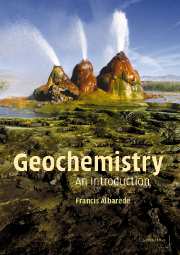Book contents
- Frontmatter
- Contents
- Foreword to the English edition
- Foreword to the French edition
- Acknowledgments
- Introduction
- 1 The properties of elements
- 2 Mass conservation – elemental and isotopic fractionation
- 3 Geochronology and radiogenic tracers
- 4 Element transport
- 5 Geochemical systems
- 6 Waters present and past
- 7 Mineral reactions
- 8 The solid Earth
- 9 The Earth in the Solar System
- 10 The geochemical behavior of selected elements
- Appendix A Composition of the major geological units
- Appendix B The mixing equation for ratios
- Appendix C A refresher on thermodynamics
- Appendix D The Rayleigh distillation equation
- Appendix E The geological time scale
- Appendix F An overview of analytical methods
- Appendix G Physical and geophysical constants
- Appendix H Some equations relative to residence time
- Further reading
- Index
Appendix F - An overview of analytical methods
- Frontmatter
- Contents
- Foreword to the English edition
- Foreword to the French edition
- Acknowledgments
- Introduction
- 1 The properties of elements
- 2 Mass conservation – elemental and isotopic fractionation
- 3 Geochronology and radiogenic tracers
- 4 Element transport
- 5 Geochemical systems
- 6 Waters present and past
- 7 Mineral reactions
- 8 The solid Earth
- 9 The Earth in the Solar System
- 10 The geochemical behavior of selected elements
- Appendix A Composition of the major geological units
- Appendix B The mixing equation for ratios
- Appendix C A refresher on thermodynamics
- Appendix D The Rayleigh distillation equation
- Appendix E The geological time scale
- Appendix F An overview of analytical methods
- Appendix G Physical and geophysical constants
- Appendix H Some equations relative to residence time
- Further reading
- Index
Summary
The analytical methods of geochemistry are many and varied, but they can be grouped by family depending on what is to be analyzed. Setting aside the high-temperature and high-pressure experiments that involve methods often borrowed from mineralogy and petrology, these methods fall roughly into three groups depending on what is to be measured:
concentrations;
isotopic ratios;
speciation of elements in solutions, mineral phases, or organic matter.
We will omit the last item here, as the variety of methods would involve substantial developments with a large physics content about spectroscopic methods.
Measurement of concentrations
Two general principles are commonly used. The first one uses comparison with a reference material by means of calibration curves and only requires from-the-shelf reagents, while the second one, isotope dilution, requires artificially altered nuclide mixtures. In the first case, the operator compares the response to physical stimulation (radiation, ionization) by means of a suitable detector upon the passage of a solution containing the dissolved sample and a set of reference solutions. The first step of most procedures is the dissolution of the powdered sample in hydrofluoric acid (HF), the only acid to dissolve silicates. Often this attack phase is replaced by melting of the sample powder in a lithium meta-borate “flux,” the addition of which lowers the melting point of the mixture for all the minerals, even the most refractory ones (zircon, oxides).
- Type
- Chapter
- Information
- GeochemistryAn Introduction, pp. 223 - 229Publisher: Cambridge University PressPrint publication year: 2003

